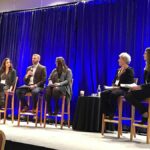Kristen Sheeran, PGE’s director of resource planning and sustainability strategy, talks about the utility’s clean-energy plan.
House Bill 2021, which then-Gov. Kate Brown signed into law in 2021, requires electricity providers to reduce carbon emissions to 80% of baseline emissions by 2030 — and to release their plans for doing so by 2023. At the end of March, Portland General Electric released its inaugural Clean Energy Plan and 2023 Integrated Resource Plan — two documents that, together, are intended as a road map for how the utility plans to meet those targets.
PGE says it’s going to hit those targets by investing in the following: new, utility-scale renewable projects like large wind and solar installations, both in-state and out-of-state; non-emitting capacity like batteries; community-based renewable energy and customer-sited solutions; and participation in regional markets and partnerships, particularly in intermittent resources like solar energy from the Southwest or wind from Montana.
This spring Oregon Business spoke with Kristen Sheeran, PGE’s director of resource planning and sustainability strategy, about the company’s decarbonization plans. Sheeran has worked for PGE since October 2021; previously, she served as Gov. Kate Brown’s energy, climate and transportation policy advisor. Prior to that, she held roles at 3Degrees, Climate Solutions and Ecotrust.
This interview has been edited for space and clarity.
What percentage of PGE’s power currently is from carbon-emitting sources?
As of the end of 2022, the last year for which we have sort of full data available, 39% of the known and specified resources on our system came from non-emitting resources — primarily hydro, wind and solar.
And so the goal is to be almost completely renewable by 2030.
Well, our target is to reduce emissions by 80%, below a baseline level of emissions that the state has established for us; we have to report emissions below that threshold at or before the year 2030. And that’s an 80% reduction on our system. By 2035 we have to be at a 90% reduction, and by the year 2040, we have to have 100% reduction, which means that by 2040, 100% of the power we serve our customers has to be zero emissions — it has to come, at that point, 100% from non-emitting resources.
When you say non-emitting resources, can you define that for me?
Those are energy resources that do not generate greenhouse gas emissions. So, when we talk about non-emitting resources, we’re primarily talking about renewable resources like wind, solar and hydro — but also batteries. We’re increasingly looking at batteries as a resource option for storing energy. In the future, there are other non-emitting resources that may become more cost effective and commercially available to us to utilize to meet our carbon targets. And that might include things like hydrogen or nuclear, which are not renewable-energy resources, but they are non-emitting from a GHG perspective.
The plan also mentions new utility-scale renewable projects, like wind and solar installations. What’s the plan for installing that infrastructure?
As we look ahead to that 2030 emissions reduction — as well as the additional load growth that we see anticipated for our system — we are going to be looking at using every proverbial clean-energy tool in the clean-energy toolbox. So, certainly large, utility-scale resources like wind and solar facilities, but we’re increasingly going to be looking toward customer-sited and community-sited resources as well. Those are things like distributed energy resources, solar and storage on customer homes or businesses. We’ll be looking at all of that to meet those future energy needs.
Now, what we do in our integrated resource planning and clean-energy plan is we identify those needs and what we think today — given what we know to be true about markets, about technology, about our system — we forecast sort of what we think the optimal portfolio of resources could be to meet that need. Then that optimal portfolio informs a proposed set of actions that the utility will take in the near term to go out and procure resources. That whole process is overseen by the Oregon Public Utility Commission. We, at that point, will select the resources with OPUC that will meet the best interests of our customer — in terms of cost and reliability and, of course, carbon. What we ultimately bring back to the system in terms of wind and solar and batteries will really be dependent on how the market responds to that request for proposals that will flow out of the planning that we have just completed.
Is this work going to be contracted out?
The way in which utilities procure resources is carefully overseen and regulated by the OPUC. We identify a resource need, and the characteristics of the resources that we need, that informs a request for proposals that goes out to the market. We then receive bids that come in from various developers, and then we’re required to select the projects through that competitive bidding process that best meet our energy needs and the interest of our customers in terms of cost. So that could result in resources that are wholly owned by a third party, where we are just procuring the power on contract through a long-term power purchase agreement, or it could result in resources that the utility PGE itself owns.
It could result in hybrid, ownership structures — for example, our Wheatridge renewable-energy facility in Morrow County that came online fully just over the last year. We have an innovative partnership with NextEra Energy Resources, where we own a portion of the facility and NextEra owns the remaining portion of the facility, and we buy back energy from NextEra. Those kinds of hybrid ownership structures can basically ensure that we’re able to procure those resources at the lowest possible cost for our customers. All of that will come through that competitive bidding process.
One of the things I was wondering as I was reading was whether this plan will involve burying power lines, which I know is something people have been talking about in recent years, with fires and ice storms affecting transmission.
Those kinds of conversations come up usually in the context of steps the utilities could take to make their system more resilient to extreme weather events like wildfires and ice storms. They are certainly — among many other things — types of investments that we regularly look for and plan for and talk about, and what we call our distribution system plan that goes before the OPUC. It’s a little bit distinct from the kind of transmission solutions we’re talking about in the Clean Energy Plan.
You also talked about planning for demand. One of the things that seems to me like it is going to have a big impact on demand — and probably already is — is electric vehicles and electric vehicle infrastructure. Is that something you’re anticipating is going to increase demand? And how are you planning for it?
As a utility, our mandate is to serve load. And, increasingly, we are seeing our customers beginning to electrify different areas of their lives: their vehicles, home appliances, for some their home heating systems and cooling systems. And the same thing is true for some of our commercial industrial customers. So we know that electrification is coming to our system, and we account for that in our modeling of future load growth in these integrated resource plans, which basically accompanied our clean-energy plan filing.
So we’re always looking out across the horizon to try to forecast as accurately as we can what we think that load growth will be. This is a highly dynamic period of change for our industry, particularly when you look at what’s happened with federal and state policies and incentives toward electrification, the IRA, and the IGA that passed from the federal government to facilitate and encourage a clean-energy transition nationally — it’s going to encourage a lot of electrification for vehicles, for heat pumps and in other ways. We filed this plan in March, and we will continue to revisit as those federal incentives, those dollars, begin to make their way down from the federal government to state, to localities and to our customers. We will look at how customers are responding and what we are seeing in terms of the uptake of electric vehicles, but there is no doubt that we’re already seeing significant increases in transportation electrification in Oregon. Oregon, like Washington and California, will no longer allow sales of internal combustion engines beyond 2035. We talk regularly with major auto manufacturers. They’re already talking about sort of, you know, earlier dates than that in terms of when they plan to have their vehicle portfolio on the West Coast be 100% electric. It’s coming and we’re getting ready for it.
Click here to subscribe to Oregon Business.







